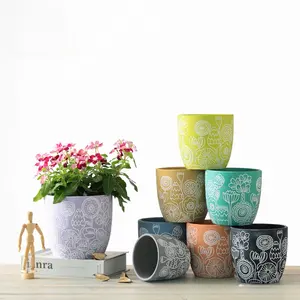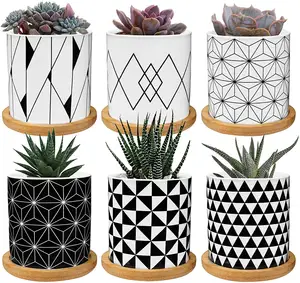(34801 products available)





































































































































































































A small planter is a container for plants. It can be indoors or outdoors. It is usually smaller than 12 inches in width or diameter. Small planters are suitable for growing herbs, flowers, and small vegetables. They work well in limited spaces like balconies, patios, or kitchen counters. They come in various materials, such as plastic, ceramic, wood, or metal, and can be found in different styles to complement any home decor. They offer a practical solution for gardening in confined spaces while adding greenery and beauty to living areas.
Hanging planters
These planters are suspended from ceilings or brackets, making them perfect for trailing plants like pothos, ferns, or ivy. They add greenery without occupying floor space. They often come in macrame styles or ceramic pots.
Wall-mounted planters
These are planters mounted on walls, creating a vertical garden. They can hold individual plants or have multiple slots for small planters, ideal for herbs, succulents, or flowers.
Tiered planters
These planters have several levels or tiers, allowing users to grow various plants vertically. They are great for herbs, strawberries, and flowers and save space while creating an attractive display.
Rail planters
Designed to fit over balcony or patio rails, these planters provide an excellent option for urban gardeners. They are perfect for growing herbs, flowers, and small vegetables and help secure the planters in open spaces.
Bucket planters
These are small buckets used as planters. They can be made of metal, wood, or plastic. They are often recycled to create a rustic or DIY garden style. Bucket planters can grow herbs, flowers, and small vegetables.
Glass jar planters
Repurposed glass jars, like mason jars, make creative and eco-friendly planters. They are perfect for succulents, herbs, and small indoor plants. Their transparent nature allows for visible soil and root growth, adding a unique touch to gardening.
Tea cup planters
Old tea cup planters are other small indoor planters. They are lovely and add a vintage touch. They work well for small plants like air plants, succulents, or moss.
Wooden crate planters
These are small wooden crates. They are versatile and provide a rustic look. Wooden crate planters can be used to grow different plants and can be easily moved around the garden.
Spoon and Fork Planters
These are small cutleries used as planters. They are creatively and innovatively used as planters. They give a unique and stylish look to gardens and are suitable for growing small plants.
Modular planters
These planters come in various shapes and sizes, allowing users to create a custom garden that fits their space. Modular planters often have features like built-in irrigation systems, drainage panels, and interlocking pieces to make them easy to use and maintain. They are also designed to be aesthetically pleasing, with sleek lines and modern finishes that can complement any outdoor or indoor decor.
Vertical wall planters
These planters are designed to be mounted on walls, which frees up floor space for other uses. Vertical wall planters often include features like removable planting pockets, built-in water reservoirs, and easy-to-hang brackets that make them simple to install and maintain. They are also designed to be stylish, with contemporary finishes and colors that can enhance any indoor or outdoor area.
Tiered planters
These planters have multiple levels, allowing users to grow a variety of plants without taking up too much space. Tiered planters often include features like removable planting boxes, built-in irrigation systems, and collapsible frames that make them easy to use and maintain. They are also designed to be attractive, with sleek lines and modern finishes that can complement any outdoor or indoor decor.
Raised bed planters
These planters are elevated off the ground, making it easier for users to tend to their plants. Raised bed planters often have features like modular sections, built-in soil grids, and edge benches that make them user-friendly and low-maintenance. They are also designed to be pleasing to the eye, with clean lines and contemporary finishes that can suit any outdoor or indoor space.
Self-watering planters
These planters are designed with an irrigation system that automatically waters plants as needed. Self-watering planters often include features like water level indicators, overflow drainage systems, and fill openings that make them easy to use and maintain. They are also designed to be attractive, with sleek lines and modern finishes that can complement any outdoor or indoor decor.
Smart planters
These planters are equipped with technology that monitors and controls plant care. Smart planters often have features like app connectivity, automated lighting systems, and climate control sensors that make them user-friendly and low-maintenance. They are also designed to be stylish, with contemporary finishes and colors that can enhance any indoor or outdoor space.
Small planters are a must-have for gardening enthusiasts. They allow users to explore various creative possibilities and make the best use of their space. Small planters are a great option to consider for those who want to add greenery to their home. These are some popular ways to use small plant pots.
Indoor gardens
Small planters are perfect for indoor gardening. They allow users to grow herbs, succulents, and small houseplants inside. Small planters are great for places with limited space, such as balconies or windowsills. They enable users to create miniature gardens and add greenery to areas without much room for outdoor gardening.
Decorative centerpieces
Small planters make attractive centerpieces for tables at events like weddings, parties, or even everyday dining. People can use them to display a variety of plants, from delicate flowers to lush ferns. Small planters add a touch of elegance and natural beauty to any gathering.
Personalized gifts
Small planters can be used to create unique, thoughtful gifts. People can fill them with their recipient's favorite plant or herb and add a personalized touch by decorating the planter. Whether for birthdays, holidays, or just because, a small planter gift is a gesture that shows care and consideration.
Desk decor
A small green oasis can help break the monotony of work desks. Adding a small pot to the office can make the place look better. It can also improve the air quality and reduce stress. Whether it is a thriving cactus, a low-maintenance pothos, or a fragrant pot of mint, a small planter provides company with a green friend throughout the workday.
Event and wedding favors
Small planters are great for giving guests a memorable keepsake. They can be filled with small plants like succulents or seeds for guests to grow. Using small planters as favors gives a practical gift that helps guests remember the event. It reflects the host's appreciation and adds a personal touch to the celebration.
Terrariums
Small, transparent planters are ideal for creating terrariums. These mini ecosystems are easy to maintain and provide a fascinating glimpse into the plant world. People can layer soil, sand, and moss in their small planters to make beautiful terrariums. They can also add decorations like tiny figures or stones to make them unique.
There are several things to consider when choosing a small planter for the home. These include:
The Type of Material
Small planters are made from a variety of materials. Each has its pros and cons. For example, ceramic planters are stylish and retain moisture well. Metal planters, on the other hand, are durable and have a contemporary look. Wooden planters are natural insulators and provide good drainage. Plastic planters are light and affordable. Glass planters elevate the decor and allow root visibility. When choosing a small outdoor planter box or indoor planter, consider the material. Choose one that will suit the plants and the desired aesthetic.
The Size and Depth of the Planter
The size and depth of the planter should match the plant. This will give the roots enough room to grow. It will also help to avoid root binding. A good rule of thumb is to choose a planter that is at least twice as wide as the plant's root ball. It should also be deep enough to accommodate the roots. Avoid choosing a planter that is too small. It will stress the plant and hinder growth. Also, avoid choosing one that is too large. It may hold too much water and cause root rot.
Drainage is Key
Many planters need better drainage, which can be a problem for plants. Without drainage, water can build up at the roots and cause root rot. Choose planters with drainage holes. They will allow excess water to escape. If the chosen planter doesn't have drainage holes, consider adding some gravel or stones at the bottom. It will help create a space for water to collect away from the roots.
Style and Aesthetics
The planter should complement the home decor. It should also highlight the plants. Choose planters that have colors and designs that go well with the home. For example, a sleek, modern ceramic planter may suit a minimalist interior. A rustic wooden planter may suit a country-style kitchen better. Always consider the aesthetics before making a choice.
Climate Considerations
The outdoor climate should also be considered when choosing a small outdoor planter. Metal planters can become very hot in the sun in some areas. They may damage sensitive plant roots. Planters made from materials like stone or concrete may be better choices in such places.
Q1: What are the benefits of using a small planter box?
A1: Small planter boxes can create a garden anywhere. They are affordable, easy to maintain, and make gardening accessible.
Q2: What materials are small planters made from?
A2: Small planters are made from many different materials. These include ceramic, plastic, wood, metal, and concrete.
Q3: How can one decorate a small planter?
A3: Small planters can be decorated by adding paint, stickers, mosaic tiles, or natural materials like jute or burlap.
Q4: What factors should be considered when choosing a small planter?
A4: When choosing a small planter, one should consider the material, drainage, size, depth, and the type of plant to be housed.
Q5: Why are wooden small planters popular?
A5: People like wooden small planters because they are natural, have a classic look, and can be treated for outdoor use.